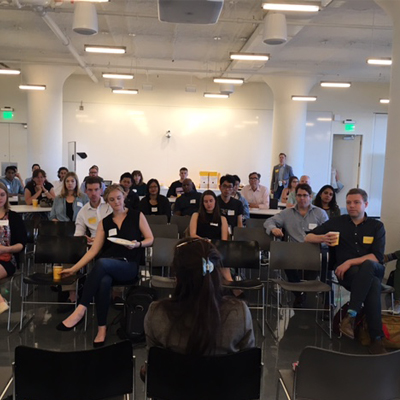Helfand on The Next Stage
Prototyping a New Model of Public Speaking in Continuum’s Boston Studio
Disclosure: Not long ago, this blog published an essay on transparent design—and it now seems rather incomplete. “Going Public: The Brave New World of Transparent Design” was too absolute in its understanding of designing in public. The piece suggested that public design is brave, while private design is hiding something. The naivety reminds me a bit of Walt Whitman, who boldly invites us to:
Unscrew the locks from the doors!
Unscrew the doors themselves from their jambs!
The most important thing about transparency, I now think, is reciprocity. You need to know what each side is giving and getting. For instance, if a person gives a social network years and years of posts and photos and emojae, and in turn, the network sells her information to advertisers—that’s not transparency but exploitation. “Relation is reciprocity,” writes Martin Buber in his legendary philosophical tome I and Thou, and it seems a great axiom for our transparency-obsessed, social-media-driven age.
I bring this up because Continuum was recently part of an event, at our studio in Boston, that put reciprocal transparency to the test. On May 19, we invited Jessica Helfand—co-founder of Design Observer and perhaps the best damned conversationalist I’ve ever met—to pilot a project she calls The Next Stage.
Helfand used the occasion to create, on the spot, an anti-TED talk, in which the meaning of the event was the creation of a worthwhile real-time conversation, as opposed to a session of star worship. This was the rhetorical equivalent of allowing commentators to participate in the writing of an essay. Many authors say: “Don’t read the comments”; Helfand began with the comments. The comments were the event!
In the aftermath of TNS, I asked Helfand, via DM, what her biggest fear for the prototype was.
“My biggest fear was resistance—to the idea itself,” she typed. “But in truth, this is an idea whose time has come. We are past the perfectly chiseled TED-talk model, and its one-way claim for inspiration from the mountaintop. It's not about ‘human-centered’ but human, about actual people engaged with one another, talking honestly and frankly about difficult questions.”
TNS was electrifying, inspiring some to blog, but it hardly spelled the end of the line for other conventional, more structured events. It was an evolutionary experiment. For the next iteration of TNS, Helfand will take show on the road—to Google in California. This time around she’s bringing the New York Times' Allison Arieff with her.
 What’s she thinking about for Next Stage 2.0? Helfand says that she wants next to “concentrate on more diversity of input. Diversity of discipline, perspective, even (and especially) vocabulary. A conversation that isn't a cycle of self-perpetuated platitudes. A real conversation about serious things.”
What’s she thinking about for Next Stage 2.0? Helfand says that she wants next to “concentrate on more diversity of input. Diversity of discipline, perspective, even (and especially) vocabulary. A conversation that isn't a cycle of self-perpetuated platitudes. A real conversation about serious things.”
Which means?
“It's how we reconcile design with ugliness, hardship, and unknowns: worrying a little less about the faux tin foil illustration on the burrito emoji and a little more on design as an expression of belief systems. It's getting out in front of questions today before the answers of tomorrow are too entrenched in policy and playbooks. It's about reciprocity in conversation—not pontificating from a podium—which makes all of us catalysts for change.”
The change manifested itself in several long letters Helfand received after TNS. What did she think of them? Did they make her rethink any aspects of the event? Did she usually receive such missives after a speaking engagement? And is there any way to to incorporate such post-TNS correspondence into the process itself?
“In fact, no, I rarely get letters following speaking engagements and these letters were long and heartfelt—proving perhaps that we hit a nerve, and the nerve was highly personal and individual. And real.”
Helfand wondered, via DM, if TNS could lead to a “different editorial model. Interesting that in an age in which nobody reads that these people took the time to think, reflect, digest—and respond.” She continued, saying that “when people feel that they are being heard, they think differently. React to others differently. View their role in their lives, and the lives of others, differently.”
Not everyone, however, was so moved. One attendee, someone whose opinion I respect, said he was a little disappointed in the conversation. He felt like the interactions with the audience were superficial and fast. After thinking about it for a moment, it was true. In a group of 70 people, you can’t go from person to person, having one conversation at a time, in a really deep way. Even as Helfand connected one’s person story to another—which she did well—it didn’t lead to exquisite new insights or personal revelations. My friend wanted more guidance.
Colleen Dunning, event attendee, agreed that the size was an issue, tweeting: “I think the seminar is a good model so 15-20. Big enough for varied voices, small enough for all to participate.”
Yet when I asked, on Twitter, if people felt “heard” at TNS, numerous attendees, including Aaron Hatley, answered in the affirmative: “Yes—and really felt like it could be an opening session for a longer event (as all the spontaneous after-convo attests).”
In short: TNS seemed to suggest that we must aspire to a degree of quid pro quo, if we are to be true humanists. The sage needs to exit the stage, to step down with genuine humility, and work instead to cultivate legitimate conversations with the people in the audience. Perhaps then we can truly begin to change things. At least that’s what I think. Want to find what Helfand thinks? Ask her yourself!


